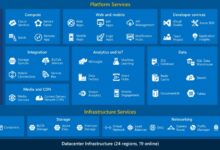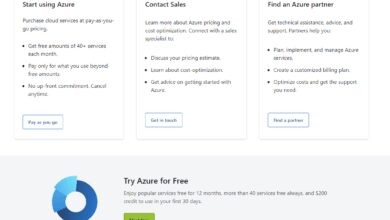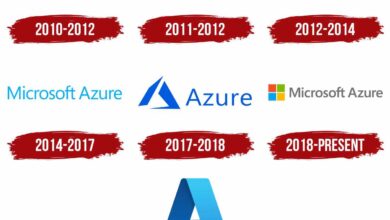Sign In to Azure: 7 Ultimate Tips for a Seamless Login Experience
Logging in doesn’t have to be a headache. Whether you’re a cloud admin or a first-time user, mastering how to sign in to Azure efficiently is your gateway to powerful cloud tools and services.
Understanding What It Means to Sign In to Azure

Signing in to Azure is more than just entering a username and password. It’s the foundational step that grants access to Microsoft’s vast cloud ecosystem, including virtual machines, databases, AI tools, and enterprise applications. This process authenticates your identity and authorizes your permissions across Azure resources.
What Is Microsoft Azure?
Microsoft Azure is a comprehensive cloud computing platform offering over 200 services, from infrastructure as a service (IaaS) to platform as a service (PaaS) and software as a service (SaaS). It supports businesses in building, deploying, and managing applications through a global network of data centers.
- Azure powers over 95% of Fortune 500 companies.
- It integrates seamlessly with Microsoft 365, Dynamics 365, and other enterprise tools.
- The platform supports hybrid cloud environments, allowing on-premises and cloud integration.
Why Signing In Matters
Every time you sign in to Azure, you’re not just accessing a dashboard—you’re connecting to a secure, scalable environment where identity is everything. Proper authentication ensures data integrity, compliance, and protection against unauthorized access.
“Your Azure sign-in is the first line of defense in cloud security.” — Microsoft Security Best Practices Guide
Step-by-Step Guide to Sign In to Azure
Whether you’re using a personal Microsoft account or a work/school account, the process to sign in to Azure is straightforward. However, knowing the nuances can save time and prevent errors.
Accessing the Azure Portal
The primary way to sign in to Azure is through the Azure portal, Microsoft’s web-based management console. Simply navigate to portal.azure.com in any modern browser like Chrome, Edge, or Firefox.
- Ensure JavaScript and cookies are enabled for full functionality.
- Use private/incognito mode only if troubleshooting session issues.
- Bookmark the URL to avoid phishing risks from fake login pages.
Entering Your Credentials
On the login screen, enter your email address associated with your Microsoft or Azure Active Directory (Azure AD) account. This could be:
- A personal Microsoft account (e.g., @outlook.com, @hotmail.com)
- A work or school account (e.g., user@company.com managed via Azure AD)
After entering your email, click “Next” and input your password. If multi-factor authentication (MFA) is enabled, you’ll be prompted to verify your identity using a phone call, text, authenticator app, or biometric method.
Navigating Post-Login: The Azure Dashboard
Once you successfully sign in to Azure, you’ll land on the Azure portal dashboard. This customizable interface displays your most-used services, resource groups, cost analysis, and alerts.
- Pin frequently used services like Virtual Machines or Storage Accounts.
- Use the search bar at the top to quickly find resources.
- Switch directories or subscriptions using the directory switcher in the top-right corner.
Common Issues When Trying to Sign In to Azure
Even experienced users encounter login problems. Understanding common issues helps you troubleshoot faster and maintain productivity.
Forgot Password or Locked Account
One of the most frequent issues is forgetting your password or getting locked out after multiple failed attempts. Azure AD typically locks accounts after 10 incorrect password entries.
- Use the “Forgot password?” link on the login screen.
- Reset via self-service password reset (SSPR) if configured by your admin.
- Contact your IT administrator if SSPR isn’t enabled.
Multi-Factor Authentication Failures
MFA adds security but can cause login delays. Common MFA issues include:
- Not receiving push notifications on the Microsoft Authenticator app.
- Using an outdated phone number or email for verification.
- Time drift on devices affecting TOTP codes.
To resolve these, ensure your authenticator app is updated and synchronized. You can also re-register your device through the My Sign-Ins portal.
Browser and Cache Problems
Sometimes, the issue isn’t with Azure—it’s with your browser. Cached credentials, extensions, or outdated cookies can interfere with the sign-in process.
- Clear browsing data (cookies, cache, site data).
- Disable browser extensions temporarily (especially ad blockers).
- Try a different browser or device to isolate the issue.
Security Best Practices When You Sign In to Azure
Security should never be an afterthought. Every time you sign in to Azure, you’re potentially exposing sensitive data. Follow these best practices to protect your environment.
Enable Multi-Factor Authentication (MFA)
MFA is one of the most effective ways to secure your Azure account. It requires two or more verification methods—something you know (password), something you have (phone), or something you are (fingerprint).
- Enforce MFA for all users, especially administrators.
- Use the Microsoft Authenticator app for push notifications and time-based codes.
- Avoid SMS-based MFA when possible due to SIM-swapping risks.
Use Conditional Access Policies
Conditional Access in Azure AD allows you to control access based on user location, device compliance, sign-in risk, and more. For example, you can block logins from high-risk countries or require compliant devices.
- Create policies that require MFA for external access.
- Block legacy authentication protocols like IMAP/SMTP.
- Integrate with Identity Protection to respond to risky sign-ins automatically.
Monitor Sign-In Activity
Azure provides detailed logs of all sign-in attempts through the Azure AD Sign-In Logs. Regularly reviewing these logs helps detect suspicious behavior.
- Navigate to Azure Active Directory > Monitoring > Sign-in logs.
- Filter by user, app, status (success/failure), or risk level.
- Set up alerts for failed logins or sign-ins from unusual locations.
“Visibility into sign-in activity is critical for proactive threat detection.” — Microsoft Azure Security Documentation
How to Sign In to Azure Using Different Account Types
Not all Azure accounts are the same. Depending on your organization or usage, you may use different types of accounts to sign in to Azure.
Work or School Accounts (Azure AD)
Most enterprise users sign in with a work or school account managed by Azure Active Directory. These accounts are created and governed by an organization’s IT department.
- Authentication is handled by Azure AD, not Microsoft account systems.
- Admins can enforce policies like password expiration and MFA.
- Users can belong to multiple directories if their organization uses multi-tenant setups.
Personal Microsoft Accounts
Individuals can use personal Microsoft accounts (e.g., @outlook.com) to sign in to Azure, especially for free trials or personal projects.
- Limited administrative capabilities compared to Azure AD accounts.
- Cannot be used in production environments requiring enterprise governance.
- Must be converted to a work account to join an Azure AD tenant.
Guest User Accounts (B2B Collaboration)
Azure supports Business-to-Business (B2B) collaboration by allowing guest users from external organizations to sign in to Azure resources.
- Guests are invited via email and authenticated by their home directory.
- Access is controlled through role-based access control (RBAC).
- Admins can monitor and revoke guest access at any time.
Advanced Methods to Sign In to Azure
Beyond the standard web portal, there are several advanced ways to sign in to Azure, especially useful for developers and system administrators.
Using Azure CLI (Command-Line Interface)
The Azure CLI is a powerful tool for managing Azure resources from the command line. To sign in:
- Install the Azure CLI from Microsoft’s official site.
- Run
az loginin your terminal. - Follow the browser-based authentication flow.
For automation, use service principals or managed identities instead of interactive login.
Signing In via Azure PowerShell
Azure PowerShell is another essential tool for administrators. Use the following steps:
- Install the Az PowerShell module.
- Run
Connect-AzAccountin PowerShell. - Authenticate through the pop-up window.
You can also sign in non-interactively using service principals for scripts and CI/CD pipelines.
Using Service Principals and Managed Identities
For applications and automation, avoid using user credentials. Instead, use:
- Service Principals: Identity for apps in Azure AD, used for non-interactive sign-ins.
- Managed Identities: Automatically managed identities for Azure resources, eliminating credential storage.
These methods enhance security by removing the need to embed passwords in code.
Troubleshooting and Recovery: What to Do If You Can’t Sign In to Azure
When standard fixes fail, it’s time to escalate. Here’s how to recover access when you’re locked out.
Contacting Azure Support
If you’re unable to reset your password or bypass MFA issues, contact Microsoft Azure Support. Depending on your subscription, you may have access to 24/7 technical support.
- Visit Azure Support to open a ticket.
- Provide proof of identity and subscription ownership.
- Escalate to higher tiers if needed (e.g., Premier or Unified Support).
Using Break-Glass Accounts
Every organization should have at least one break-glass account—privileged accounts used only in emergencies.
- Store credentials securely (e.g., in a physical safe or password manager).
- Never use break-glass accounts for daily tasks.
- Monitor and audit usage strictly.
Recovering Access via Global Administrator
If you’re locked out of your admin account, another Global Admin can reset your password or re-enable MFA registration.
- Ask a colleague with admin rights to assist.
- Use the Azure AD portal to manage user accounts.
- Ensure at least two admins are designated to prevent single points of failure.
Optimizing Your Azure Sign-In Experience
Once you’ve mastered the basics, you can optimize your sign-in process for speed, security, and convenience.
Enable Passwordless Authentication
Microsoft supports passwordless sign-in using:
- Windows Hello
- FIDO2 security keys
- Microsoft Authenticator app (biometric verification)
These methods reduce phishing risks and improve user experience.
Use Single Sign-On (SSO)
SSO allows users to sign in once and access multiple applications without re-authenticating. Azure AD supports SSO for thousands of SaaS apps.
- Configure SSO via the Enterprise Applications section.
- Supports SAML, OAuth, OpenID Connect, and password vaulting.
- Integrates with on-premises identity providers like AD FS.
Customize Your Sign-In Page
Organizations can brand their Azure AD sign-in page with company logos, colors, and messages.
- Go to Azure AD > User Settings > Branding.
- Upload your logo and set background colors.
- Add custom text for user guidance or legal notices.
How do I sign in to Azure if I forgot my password?
If you forget your password, click “Forgot password?” on the login screen. Follow the prompts to reset it using your recovery email, phone number, or security questions. If self-service password reset (SSPR) is enabled, you can complete the process yourself. Otherwise, contact your administrator for assistance.
Can I use a personal Microsoft account to sign in to Azure?
Yes, you can use a personal Microsoft account (e.g., @outlook.com) to sign in to Azure, especially for free trials or individual subscriptions. However, for organizational use, a work or school account managed through Azure Active Directory is recommended for better security and governance.
What should I do if MFA is not working during Azure login?
If MFA fails, try switching to a different verification method (e.g., phone call instead of app notification). Ensure your authenticator app is updated and synced. If the issue persists, visit My Sign-Ins to re-register your device or contact your admin to reset your MFA settings.
How can I sign in to Azure without a browser?
You can sign in to Azure using command-line tools like Azure CLI or Azure PowerShell. Run az login or Connect-AzAccount in your terminal and follow the device code flow or use service principals for automated access.
What is a break-glass account in Azure?
A break-glass account is a highly privileged emergency account used when normal administrative access is unavailable. It should be securely stored, rarely used, and monitored for any activity to ensure it’s only used in true emergencies.
Signing in to Azure is the first step in unlocking the full potential of Microsoft’s cloud platform. From basic login procedures to advanced authentication methods, understanding how to securely and efficiently access your Azure environment is crucial. Whether you’re troubleshooting login issues, enhancing security with MFA, or optimizing access through SSO, every aspect of the sign-in process plays a role in your cloud success. By following best practices and leveraging Azure’s robust identity tools, you can ensure a seamless, secure, and productive experience every time you sign in to Azure.
Further Reading:









